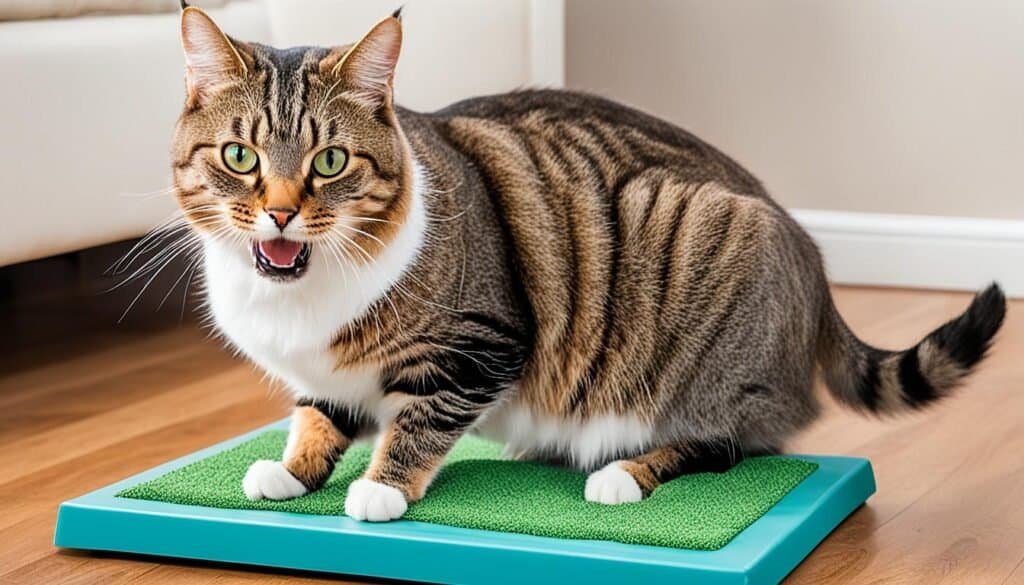Are you looking to train your cat to follow commands? Whether you want to teach basic obedience or fun tricks, effective training techniques can help you achieve your goals. In this section, we will explore a variety of cat command training tips that utilize positive reinforcement methods.
Cat obedience training involves understanding your cat’s behavior and using techniques that encourage desired behaviors. With patience, consistency, and love, you can enhance your cat’s obedience and strengthen the bond between you and your feline friend.
Key Takeaways:
- Understand your cat’s behavior and instincts to communicate better during training.
- Use positive reinforcement, such as treats and praise, to encourage good behavior.
- Consider clicker training as a method for shaping your cat’s behavior.
- Teach essential obedience commands like sit, stay, and come for a harmonious household.
- Explore the fun of teaching tricks like high five and rolling over to your cat.
Understanding Cat Behavior
Before embarking on any cat behavior training or cat training techniques, it is crucial to have a deep understanding of your furry friend’s natural instincts and behaviors. By comprehending the way cats think and interact, you can effectively communicate with them and build a stronger bond.
Cats are unique creatures with their own set of instincts and behaviors. They are independent, territorial, and highly sensitive to their surroundings. Understanding these traits will help you tailor your training methods to suit their needs and personality.
Natural Instincts
- Cats are natural predators and have a strong hunting instinct.
- They have a need to scratch, marking their territory and maintaining their claws.
- Unlike dogs, cats are more solitary animals and have a strong sense of independence.
- They have a keen sense of smell and use scent marking to communicate.
- Cats are crepuscular animals, meaning they are most active during dawn and dusk.
Behaviors and Body Language
Cats communicate through body language and vocalizations. Understanding their behaviors and signals will enable you to interpret their needs and emotions more effectively.
- Hissing: A defensive behavior to communicate fear or aggression.
- Purring: Cats purr when they are content, relaxed, or seeking comfort.
- Meowing: A vocalization used to communicate various needs, such as hunger, attention, or discomfort.
- Scratching: Cats scratch to stretch their muscles, mark their territory, and maintain their claws.
- Tail Position: A cat’s tail position can indicate their mood. A high, erect tail shows confidence, while a tucked tail signals fear or submission.
- Ear Position: Forward-facing ears indicate attentiveness and curiosity, while flattened ears suggest fear or aggression.
By understanding these natural instincts, behaviors, and body language, you can tailor your cat behavior training and cat training techniques to address their specific needs. Positive reinforcement techniques, patience, and consistency will be key in effectively shaping their behavior and nurturing a harmonious bond between you and your feline companion.
Positive Reinforcement Training
Positive reinforcement is a highly effective cat training technique that focuses on encouraging desired behaviors through rewards and praise. By using this method, you can create a positive learning environment for your feline friend and strengthen your bond. Let’s explore how you can incorporate positive reinforcement into your cat’s training routine.
1. Use Treats
Treats are a valuable tool in positive reinforcement training. Whenever your cat responds correctly to a command or displays good behavior, reward them with a small, tasty treat. Make sure to choose treats that are specifically designed for cats and are both nutritious and enticing.
2. Praise and Affection
Alongside treats, praise and affection play a crucial role in positive reinforcement. Verbal praise, such as saying “Good job!” or “Well done!” in a cheerful tone, lets your cat know they have done something right. Additionally, petting, gentle strokes, and cuddles can further reinforce their positive behavior and create a sense of connection between you and your cat.
3. Timing is key
Timing is crucial when using positive reinforcement. The reward should be given immediately after your cat exhibits the desired behavior. This helps them make a clear association between their action and the reward, reinforcing the behavior you want to encourage.
4. Consistency and Patience
Consistency is key when training your cat using positive reinforcement. Use the same commands and rewards consistently to help your cat understand what you expect from them. Remember, cats may take time to learn and adjust, so maintain patience and be consistent in your training efforts.
5. Gradual Progression
Start with simple commands and behaviors when training your cat. As they become more comfortable with the training process, you can gradually introduce new commands or behaviors. This step-by-step approach ensures that your cat remains engaged and motivated throughout the training process.
By employing positive reinforcement techniques, you can create a positive, enjoyable training experience for your cat, making learning fun and rewarding for both of you. Remember to keep sessions short and frequent, and always end on a positive note. Be consistent, patient, and watch your cat thrive under positive reinforcement training.
Clicker Training for Cats
Clicker training is a highly effective and popular method for training cats. This technique utilizes a small handheld device called a clicker as a marker to reinforce desired behavior in your feline friend. The clicker emits a distinct sound that signals to your cat that they have performed the correct action. This clear communication helps your cat understand what behavior is being rewarded.
Clicker training is based on the principles of positive reinforcement, which involves rewarding your cat for exhibiting the desired behavior. By associating the clicker sound with a pleasant outcome such as treats or praise, your cat learns to repeat the behavior that triggered the clicker.
The process of clicker training involves three simple steps:
- Charge the clicker: Before you begin training, you need to introduce your cat to the sound of the clicker. Hold the clicker in one hand and offer your cat a treat with the other hand. As soon as your cat takes the treat, press the clicker to produce the sound. Repeat this process several times until your cat associates the click with the treat.
- Mark the behavior: Once your cat understands the association between the clicker and the treat, you can start using the clicker to mark the desired behavior. For example, if you want to teach your cat to sit, wait for them to naturally sit, and immediately click the clicker when they do so. Follow the click with a reward such as a treat or a gentle pat.
- Reinforce the behavior: Consistency is key in clicker training. Use the clicker and reward every time your cat performs the desired behavior. Over time, your cat will begin to associate the clicker with positive reinforcement and will actively seek to repeat the behavior to receive the reward.
Clicker training is a versatile technique that can be used to teach various commands and tricks to your cat. It is particularly effective in shaping behaviors that may be more challenging to teach using other methods. Remember to keep the training sessions short and enjoyable for your cat, and always use positive reinforcement to create a positive learning environment.
Basic Obedience Training
Building a foundation of basic obedience commands is essential for creating a harmonious household with your feline companion. By teaching your cat essential commands such as sit, stay, and come, you can ensure that they understand and obey your instructions.
Start by using positive reinforcement techniques, which will help your cat associate the commands with rewards and praise. Here’s a step-by-step guide to get you started:
- Begin with one command at a time. Start with “sit” as it is an easy command for most cats to learn.
- Hold a treat close to your cat’s nose, then slowly move it upwards and slightly backwards. This will naturally make your cat sit down.
- As your cat sits, say the command “sit” in a clear and firm voice.
- Immediately reward your cat with the treat, along with verbal praise such as “Good job!”
- Repeat this process several times a day, gradually increasing the duration your cat remains seated before receiving the treat.
- Once your cat has mastered the “sit” command, move on to “stay” and “come.”
- For “stay,” ask your cat to sit, hold your hand up in a stop gesture, and take a few steps back. If your cat stays in place, reward them and praise them.
- For “come,” call your cat’s name followed by the command “come” in an inviting tone. When your cat comes to you, reward them and offer praise.
https://www.youtube.com/watch?v=PBqu90T_Dxc
Remember, consistency is key when it comes to cat obedience training. Practice these commands daily in short sessions to reinforce the behavior. Keep the training sessions positive, rewarding your cat for their efforts and progress.
With time and patience, your cat will become proficient in these basic obedience commands, creating a stronger bond between you and your feline friend. Enjoy the process of training your cat and celebrate their accomplishments along the way!
Teaching Tricks to Your Cat
Beyond basic obedience, teaching tricks can be a fun and rewarding experience for both you and your cat. Not only does it provide mental stimulation for your feline friend, but it also strengthens the bond between you. With a little patience and the right techniques, you can teach your cat impressive tricks that will amaze your family and friends.
One of the key principles in cat trick training is positive reinforcement. By using rewards and praise, you can motivate your cat to learn new behaviors. Treats such as small pieces of their favorite food or specialized cat treats can serve as effective rewards during training sessions. Remember to use treats sparingly to avoid overfeeding your cat. Consistency is also crucial when teaching tricks, as cats respond well to routine and repetition.
Step-by-Step Guide to Teach Cat Tricks
- Choose a Trick: Start by selecting a trick that you would like to teach your cat. Popular tricks include high five, rolling over, and playing dead. Select a trick that suits your cat’s personality and willingness to learn.
- Break It Down: Break the trick into simple and manageable steps. For example, if you want to teach your cat to give a high five, begin by encouraging them to touch their paw to your hand.
- Use a Cue: Choose a verbal or visual cue to indicate when you want your cat to perform the trick. This could be a specific word or hand gesture that you consistently use during training.
- Implement Positive Reinforcement: When your cat performs even a small part of the trick correctly, immediately reward them with a treat and praise. Gradually increase the criteria for receiving rewards as your cat progresses.
- Practice Regularly: Set aside dedicated training sessions every day to practice the trick. Aim for short sessions of no more than 10 minutes to keep your cat engaged and enthusiastic.
- Be Patient: Remember that each cat learns at their own pace. Some may master a trick quickly, while others may take more time. Stay patient, and celebrate every small achievement along the way.
By following these steps and consistently practicing, you can successfully teach your cat impressive tricks. Remember to keep the training sessions positive and enjoyable for both you and your cat. With time and dedication, your furry companion will be dazzling everyone with their newfound skills.
Ready to embark on the journey of teaching tricks to your cat? Start with a simple trick and gradually progress from there. The bond you’ll create and the joy you’ll experience together is well worth the effort. Get started today and watch your cat’s abilities soar!
Problematic Behaviors and Solutions
Cats may exhibit unwanted behaviors such as scratching furniture or excessive meowing. But rest assured, there are effective solutions to address these common behavioral issues. By understanding the underlying causes and employing proper cat training techniques, you can eliminate or redirect these behaviors.
1. Scratching Furniture

One of the most frustrating behaviors is when cats scratch and damage your furniture. To prevent this, provide your cat with alternative scratching surfaces like vertical or horizontal scratching posts. Encourage your cat to use these surfaces by sprinkling catnip or using a pheromone spray as an attractant. Additionally, regularly trimming your cat’s nails can reduce the damage caused by scratching.
2. Excessive Meowing
If your cat engages in excessive meowing, it’s important to understand the underlying reasons. Cats may meow due to hunger, boredom, stress, or even to seek attention. Ensure your cat’s basic needs, such as food and water, are met. Engage them in interactive play sessions and provide plenty of mental stimulation by introducing puzzle toys or hiding treats around the house. If the meowing persists, consult with a veterinarian to rule out any underlying medical issues.
3. Inappropriate Elimination
Inappropriate elimination, such as urinating outside the litter box, can be a frustrating behavior to deal with. First, ensure that your cat’s litter box is clean and easily accessible. Consider providing multiple litter boxes in different areas of your home. Additionally, identify any potential stressors or changes in the environment that may be triggering this behavior. Use enzymatic cleaners to remove any lingering odors and avoid using harsh chemicals that may deter your cat from using the litter box.
4. Aggression
Cats can exhibit aggression towards humans or other animals, and it’s essential to address this behavior to ensure a safe environment for everyone involved. Identify possible triggers for your cat’s aggression, such as territorial issues or fear. Employ positive reinforcement techniques to reward calm and non-aggressive behavior. In some cases, consulting with a professional cat behaviorist may be necessary to develop a behavior modification plan.
5. Excessive Nighttime Activity
If your cat is keeping you awake at night with excessive activity, create a bedtime routine that encourages relaxation. Participate in interactive play sessions before bedtime to tire your cat out. Provide a comfortable sleeping area away from any potential disturbances. Avoid engaging with your cat during the night to discourage attention-seeking behaviors. It may take time for your cat to adjust, but consistency is key in modifying this behavior.
By addressing these problematic behaviors using cat training techniques, you can establish a harmonious and enjoyable relationship with your feline companion.
Training for Leash Walking
Walking your cat on a leash can be a wonderful way to provide them with safe outdoor exploration. By introducing a harness and leash to your cat and teaching them to walk calmly, you can enjoy peaceful strolls together. Here are some essential tips for leash training your cat:
- Introduce the harness gradually, allowing your cat to get used to wearing it around the house. Use positive reinforcement, such as treats and praise, to create a positive association with the harness.
- Once your cat is comfortable wearing the harness, attach the leash and let them explore indoors. Supervise them closely and ensure there are no hazards or objects they can get tangled in.
- When your cat is confident indoors, you can start venturing outside. Choose a quiet and secure area, away from noisy streets or other animals, to minimize stress.
- Begin walking with your cat, allowing them to set the pace. Give them enough slack on the leash, but remain attentive to any sudden movements or changes in behavior.
- Use positive reinforcement to reward your cat for walking calmly. Give them treats, praise, or their favorite toys to reinforce their good behavior.
- If your cat becomes anxious or tries to escape, gently redirect their attention to something positive, like treats or toys.
- Gradually increase the duration and distance of your walks, while always respecting your cat’s comfort level. Over time, your cat will become more confident and accustomed to walking on a leash.
Remember, every cat is unique, so be patient and adapt the training techniques to suit your cat’s temperament. Enjoy the bonding experience and the opportunity to explore the world together with your feline companion!
Training for Veterinary Visits
Visiting the veterinarian can be a stressful experience for many cats. However, with the right training techniques, you can help your feline companion associate positive experiences with vet visits, making the entire process less daunting for both of you.
One effective approach is to use positive reinforcement cat training. By rewarding your cat with treats, praise, or petting during and after the vet visit, you can help create a positive association with the experience. This technique helps reduce anxiety and makes future visits more manageable for your cat.
Here are some cat training techniques to help your feline friend feel more comfortable during veterinary visits:
- Start by acclimating your cat to their carrier. Gradually introduce the carrier in your home, leaving it open with a comfy bed or blanket inside. Encourage your cat to explore and relax inside the carrier using treats and play sessions. This will help your cat see the carrier as a safe space.
- Regularly take short car rides with your cat in their carrier, gradually increasing the duration. This will help them get accustomed to the sensation of being in a moving vehicle.
- Visit the vet clinic for brief, positive experiences. Bring your cat to the clinic just to weigh them or receive treats and praise from the vet or staff. These short visits can help your cat associate the clinic with pleasant experiences.
- Ask your veterinarian for pheromone sprays or diffusers that emit calming scents. These pheromones can help create a calming atmosphere in the carrier and at the vet clinic.
- Practice handling exercises at home. Gently touch your cat’s paws, ears, and mouth to prepare them for routine examinations during vet visits. Reward your cat with treats and praise during these exercises to reinforce positive behavior.
Remember, patience and consistency are key when training your cat for vet visits. It may take time for your cat to feel completely at ease, but with positive reinforcement and gradual exposure, you can make veterinary visits a more positive experience for your furry friend.

Training Multiple Cats
If you have more than one cat in your household, training them together can present its own set of challenges. However, with the right strategies and approach, you can successfully train multiple cats simultaneously, maintain order, and avoid conflicts.
1. Individual Training Sessions
Begin by working with each cat individually to establish a solid foundation of obedience. This will help you assess their individual temperaments, strengths, and weaknesses. It’s crucial to ensure that each cat understands and responds to basic commands before moving on to group training.
2. Gradual Introduction to Group Sessions
Once each cat is comfortable with individual training, gradually introduce them to group training sessions. Start by training two cats together and gradually add more cats. Be patient, as some cats may take longer to adjust to the group dynamic.
3. Separate Spaces and Resources
During training sessions, provide each cat with their own space and resources, such as separate feeding bowls and litter boxes. This will minimize competition and potential conflicts during training. Ensure that each cat has equal access to resources to prevent any feelings of inequality.
4. Positive Reinforcement and Rewards
Utilize positive reinforcement techniques and rewards during group training sessions. Reward each cat individually for their successful responses to commands. This will emphasize cooperation and encourage positive interactions among the cats.
5. Individualized Attention
While training multiple cats, it’s important to give each cat individual attention and reinforcement. This will strengthen the bond between you and each cat, as well as ensure that each cat feels valued and recognized for their progress.
6. Addressing Conflicts
If conflicts arise during training sessions, redirect the cats’ attention to individual tasks or exercises. This will help diffuse any tensions and prevent escalation. If persistent conflicts occur, consider consulting a professional cat behaviorist for further guidance.
7. Consistency and Patience
Consistency is key when training multiple cats. Set a regular training schedule and adhere to it. Be patient with each cat’s individual learning pace and adjust your approach accordingly. Remember, the goal is to create a harmonious and cooperative environment for all your cats.
By implementing these strategies and maintaining a structured training routine, you can successfully train multiple cats simultaneously. Enjoy the process of strengthening the bond between your cats and creating a harmonious household.
Conclusion
This article has provided valuable insights into effective cat command training techniques. By gaining a deep understanding of your cat’s behavior and implementing positive reinforcement methods, you can encourage obedience and build a stronger bond with your feline companion.
Training your cat requires patience, consistency, and a whole lot of love. By using treats, praise, and rewards as positive reinforcement, you can motivate your cat to follow your commands and exhibit desired behaviors.
Remember, cat training is a rewarding journey that requires ongoing practice and dedication. With the right techniques and a positive attitude, you can shape your cat’s behavior, teach them tricks, and address any problematic behaviors that may arise.
So, get ready to embark on an exciting training adventure with your cat. Train them with kindness, respect, and understanding, and enjoy the remarkable transformation that comes from a well-trained feline companion.
FAQ
Can all cats be trained to follow commands?
What is the best way to do cat command training using positive reinforcement?
How long does it take to train a cat to follow basic obedience commands?
What is clicker training, and how does it work for cats?
How can I stop my cat from scratching furniture?
Can cats be trained to walk on a leash?
How do I train my cat to enjoy veterinary visits?
Should I train each of my cats individually, or can I train them together?
Last modified: March 11, 2024














[…] understanding your cat’s behavior and utilizing these cat training tips, you can establish a strong foundation for successful feline behavior training and agility […]
[…] following these indoor training tips, you are laying the foundation for successful outdoor walks with your cat. Practice patience, […]
[…] establish a harmonious relationship with your beloved pet. In this section, we will provide expert tips for Cat Behavioral Training, focusing on techniques for cat behavior modification and feline behavior […]